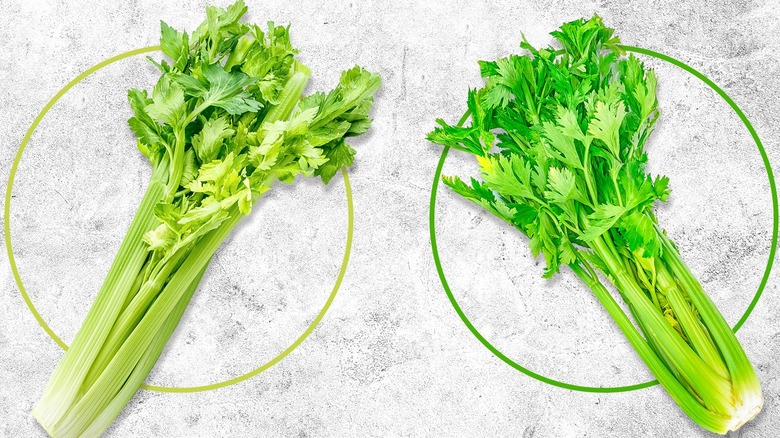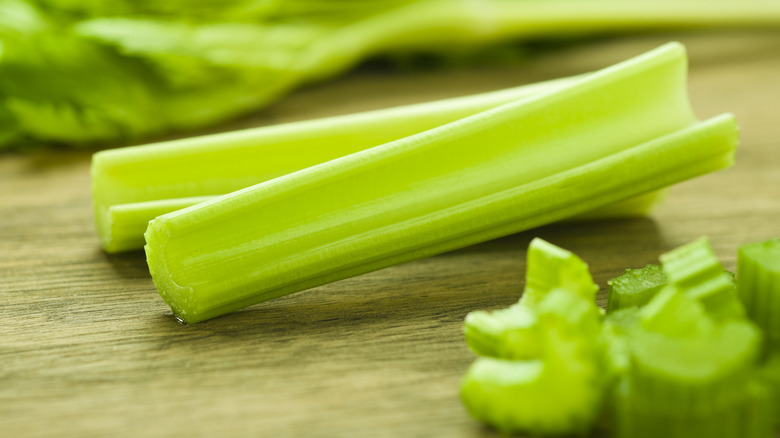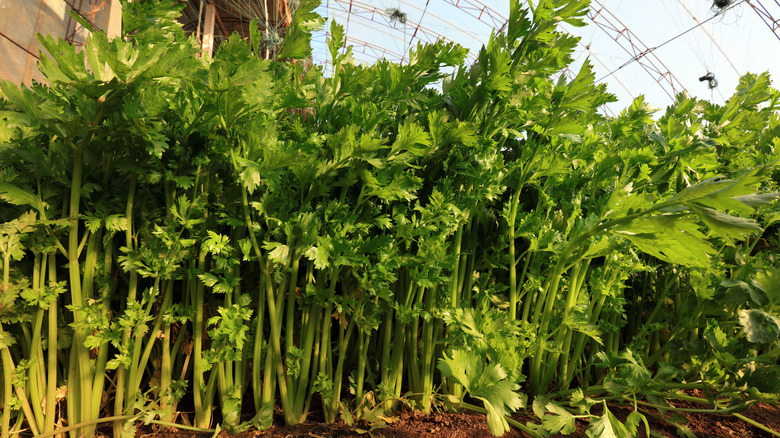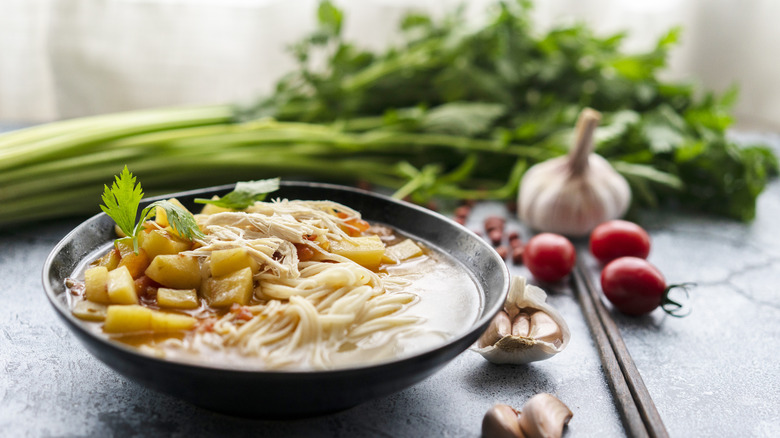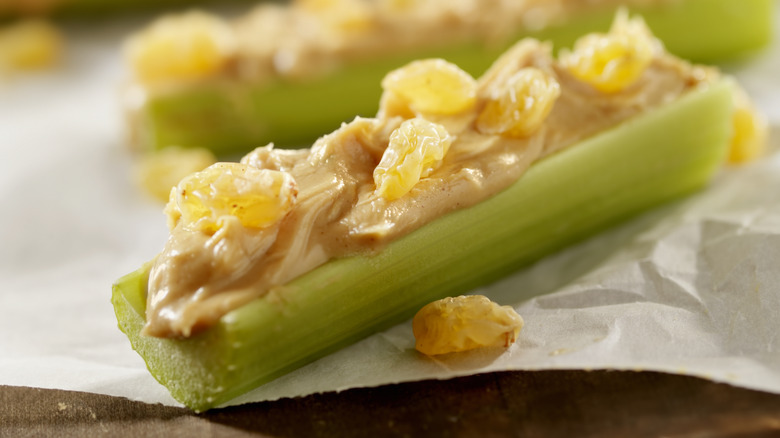Western Celery Vs Chinese Celery: What's The Difference
Although vegetables may seem like a straightforward pantry staple, each one actually comes in a surprising number of varieties. Take celery, which comprises three common versions in a single species. In addition to the long, green, and stalky vegetable you're already familiar with, there's the underrated celeriac, cultivated for its root. Plus, there's also Chinese celery, or leaf celery, which looks like a smaller, leafier version of Western celery with skinnier stalks.
Visually, Chinese and Western celery may be fairly similar, but you won't want to confuse the two vegetables. Chinese celery is all about its strong aroma, which infuses dishes through the use of both leaves and stems. Peppery in raw form and sweeter when cooked, it's a plant marked with a distinct culinary character and tradition.
Meanwhile, Western celery is also a cornerstone ingredient, typically featured in dishes cooked in Europe, North America, and Africa. A foundational aromatic often complemented with onions or simply a raw ingredient on its own, it's a grocery store stalwart that's both common and simultaneously underappreciated.
What is Western celery?
Vibrant green celery hails from the Mediterranean and Middle Eastern regions, and has been consumed for centuries. Its original varieties came in an herb-like form; it was only in the 18th century that it was cross-bred specifically for its stalk. In the U.S., most celery varieties stem from such specific European-created versions of the plant. Known for its savory, herbal, and delicious flavor, this ingredient is referred to as Western celery.
Of course, the vegetable makes for a delicious raw snack, served as part of a crudités platter or alongside buffalo wings. However, the stalk's complex flavor, which unites herbal notes with a dash of bitterness and some pungency, forms the foundational backbone of many dishes. It's chopped into small pieces to form a mirepoix alongside onions and carrots, which then forms the base flavor of so many Mediterranean soups, stews, and sauces. Cut a little coarser, and it becomes an Italian soffrito, frequently employed as a sauce base. And joined by peppers and onions, it creates the aromatic Holy Trinity base essential to Cajun and Creole cuisines. Once a luxurious and fashionable food during the Victorian era, housed in specially bought celery vases and served to the Titanic's first-class passengers, celery is now omnipresent in Western cuisine.
What is Chinese celery?
Chinese celery's stalks are thinner than those of Western celery, and are hollow, which lends them a far more bendable, less robust shape. The leaves, which are also edible, are smaller and dark green, reminiscent of parsley in appearance. In fact, it can appear more like a bunch of herbs than a sticky vegetable. The foodstuff has a pungent flavor with an intense hit of spice and aromatics. This makes it similar to smallage, an earlier version of the vegetable, sometimes referred to as wild celery.
The Chinese variant emerged as a standalone version around two thousand years ago. In addition to centuries-old culinary use, it's esteemed for its medicinal effects. As a result, it's enjoyed during events like Lunar New Year, prepared into stir-fries, soups, and braises for good luck. This celery type is also found in Thai cuisine, where it's known as phak chi lom. And it's enjoyed in Vietnam, too, where it goes by the name of can tau. Such ubiquity makes it pretty easy to find in an Asian grocery, although you may sometimes find it called Japanese parsley.
Chinese celery requires cooking
With a punchier flavor and a more fibrous texture to its stalks, Chinese celery isn't used raw. Its sharp, peppery taste necessitates heat to mellow out. Due to its similar appearance to Western celery, the far stronger taste can be surprising. Plus, its consistency is more rigid, meaning it takes a little more know-how to cook.
Stir-frying is an especially popular use, transforming the vegetable into a succulent and slightly sweet vegetable side. Chinese celery is also found as a filling for dumplings, and an addition to fried rice. It can also be blanched for ease of dish combination. While western celery can be utilized in similar applications, the two vegetables aren't a direct substitution. Some recipes suggest cilantro or scallions as a better substitute.
Chinese celery leaves also transform once cooked — invoking a sweet, complex aromatic. They're a core flavoring in canh ngot ca mu, a spicy Vietnamese soup crafted with cod. Plus, they add a distinct note to noodles cooked in broth with pork. While such uses are more common in East Asian cuisine, some Mediterranean recipes call for the ingredient, too; Greeks employ wild celery for flavoring stews, for example. And although there are several good uses for Western celery leaves, they don't offer quite the same taste, so do look for Chinese celery if that's what your recipe calls for.
Western celery's gentler flavor melds into dishes
Western celery's greatest hurdle is its texture, frustrating cooks with its fibrous strings and rigid consistency. You can employ a simple vegetable peeler trick to remove that annoying exterior, making the plant much more palatable. Chopped, the vegetable forms a delicious crunchy salad base, easily integrating with a range of other ingredients. That crunch is also the fresh essential element when used as an edible stirrer in a bloody Mary cocktail, as well as a scoop for delicious dips. A tasty salad with Chinese celery is also possible, but you'll need to blanch the vegetable to make it work.
You'll also find Western celery subtly appearing in contexts like stocks, roasts, casseroles, and other slow-cooked dishes. Once prepared, the vegetable has a gentle, sweet, and lightly herbal flavor that won't dominate a dish. This flavor makes it handy for dishes like stuffing, where it's present yet not dominant. Plus, roasting turns the stalk soft, making it less noticeable in a bite. Conversely, dishes like stir fries prepared with Chinese celery retain the vegetable's crunch, making it a more central textural element.
